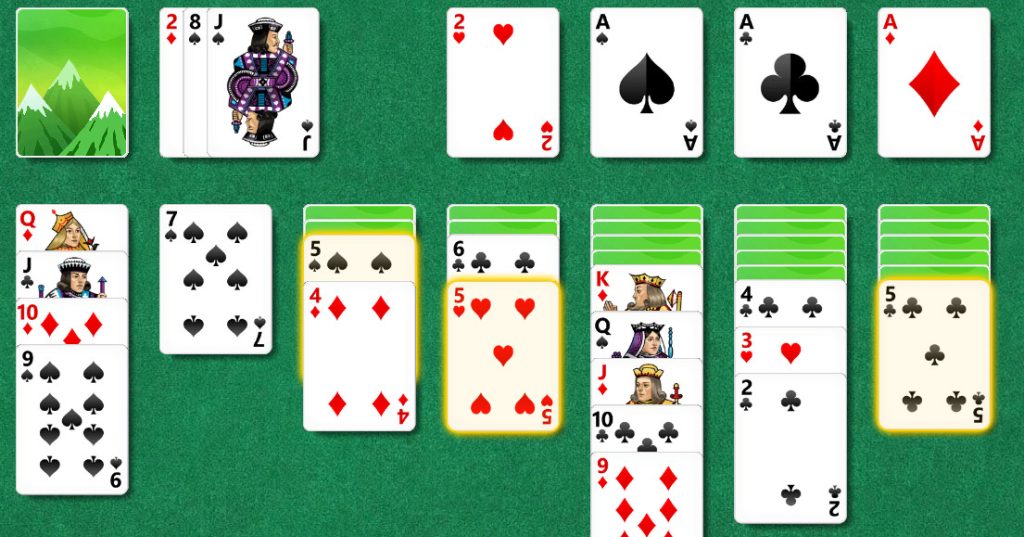Incorrectly, the name “Solitaire” is frequently used to describe a particular class of card game known in the UK as Patience or Klondike. There are actually several varieties of solitaire games.
The most widely played variation of the game is still Klondike. After all, after being included into Microsoft’s software in the early 1990s, it was the first to spark the enormous popularity of this genre of card games. However, there are currently a number of rival versions vying for first place.
The most well-known varieties of solitaire games are quite similar to one another, in part because they are all intended to be played by a single person (thus the term Solitaire). But even in their little distinctions, they stand out as difficult on their own.
1. Klondike
The most widely used variation of Solitaire is Klondike. So much so that this game is typically referred to when the name “Solitaire” is used alone.
Although its exact origins are unknown, it is most likely to have made its debut during the 19th century Klondike gold rush in the Canadian area from which it gets its name.
Its incorporation in Microsoft’s Windows 3.0 in 1990 can be credited with contributing to its enormous popularity.

Game-play
In Klondike, 52 cards are used. The objective is to position them on the foundations, which are vacant spaces, in order of suit, from Ace to King.
On the tableau, the cards are dealt into seven heaps (the game area). Except for the top card in each pile, all of the cards are face down. The players must create sequences and move the cards inside the piles in order to reach and disclose the bottom cards.
The tableau’s sequences are constructed using alternating colours and in decreasing order (from King to Ace). On the tableau, only Kings can be placed in open spots.
A Stock pile contains the remaining cards that were not dealt into the piles. These might be utilised to
2. Spider
Although Spider Solitaire is the most played 2-deck variant, Klondike Solitaire is the most played form overall. The eight foundations that must be constructed in order to win the game gave the game its name because spiders typically have eight legs.
According to some estimates, one in three Solitaire Spider games will end in victory.
Game-play
Two card decks are used in Solitaire Spider. It may be played with a single suit or many suits, depending on the degree of difficulty.
The tableau’s physical environment includes heaps, a Stock pile, and foundations, much like the Klondike. But because every card is visible, only whole sequences may be communicated to the foundations.
Building suit sequences from the King to the Ace within the heaps is the objective. If more than one costume is worn, the game gets much more difficult.
Every pile will receive an additional card if you tap on the Stock pile.
3. FreeCell
The Solitaire variation that most closely resembles Klondike (the standard version) is FreeCell Solitaire. However, because it calls for a more cautious and deliberate approach, it is regarded as a more strategic variation of the latter.
Even yet, it has one of the highest chances of being solved out of all the Solitaire games. It is believed that almost all of its transactions can be resolved.
Game-play
The gameplay of FreeCell most closely resembles that of Klondike. The cards are dealt into 7 piles, and it also only utilises one deck. There is no Stock pile and all cards are dealt in this game of solitaire.
The player can see the cards, which are also visible and face forward. The objective is to lay the groundwork suit by suit.
As in Klondike, sequences are constructed by suit, in ascending order in the foundations, and in descending order, with alternating colours, within the piles on the tableau.
However, the fundamental distinction between them is the presence of four vacant cells—empty spaces—on the tableau. To release persons in custody, cards can be delivered to these cells and put on hold.
Cards in free cells can only be re-called when building piles or foundation sequences. There is no possibility of exchanging cards.
4. Tripeaks
Tripeaks gets its name from the three pyramidal peaks that the cards’ tableau arrangement creates. Other names for it include Triple Peaks, Tri Towers, and Three Peaks.
Robert Hogue created the game in 1989. Over 90% of all Tripeaks games can be won, according to Hogue’s computer statistical study of the game’s original design.
Game-play
52 cards are used in this game. Three pyramids with four rows each are formed by the cards. Four cards are facing front at the base of each pyramid, with the remaining cards facing downward. The stock pile is created using the leftover cards.
To remove every card from the tableau is the aim of the game. Deconstructing the pyramids requires the player to build chains of cards, regardless of suit, that are one point higher or lower than the preceding one. A 4 can, for instance, create a sequence with a 3 or a 5, and so forth.
The discard pile receives the cards that are taken out of the pyramid. The following sequence is built on the top card of this pile. The player may use the Stock pile and send a different card to the discard pile to serve as the sequence foundation if there are no more moves left to make.
5. Pyramid
The solitary pyramid form of the dealt cards on the tableau gives Pyramid Solitaire its name. It is one of the Solitaire game variations with the lowest chance of success while having a straightforward structure and set of rules.
The many ways that cards might be laid up on the tableau and the player’s strategic decision-making determine the outcome of the game. The odds of winning are about 1 in 50 when the rules are set up so that the player can only go through the Stock pile once.
Game-play
Solitaire pairing game called Pyramid. The tableau consists of 28 cards arranged in the shape of a pyramid, all facing forward. Only the uncovered cards may be called into play.
The objective is to break down the pyramid by matching cards that, regardless of their suit, add up to 13 points (8+5=13, for example). The King is worth 13 in a typical 52-card deck and can be eliminated on its own. The Jacks are valued at 11, while the Queens are worth 12.
To try to match a card on the pyramid, the player may pull one card at a time from the Stock pile. Depending on how many times a player can win the game, the level of difficulty is established.
6. Yukon
Although Yukon Solitaire is mostly based on the classic Klondike game, its rules are very different, making it stand alone as a far more challenging game.
In Yukon Solitaire, the objective is to construct four foundations per suit, beginning with the ace and finishing with the king. But because there is no Stock pile or other kind of assistance, the rules for moving the cards across the tableau are a little trickier.
Game-play
On the tableau, a 52-card deck is arranged in 7 piles. Except for the bottom cards, which run from 1 to 6, starting on the left, all cards are visible. No stockpile exists.
The piles’ sequences are organised in descending order and alternating colours, much like in the Klondike game. The cards don’t have to be in any particular order or be unrestricted in their movement, though.
Sole free cards may be topped is the only restriction. To create ascending sequences by suit on the foundations, move the cards around and uncover the appropriate ones.
Other popular types of Solitaire games
Despite the many variations within each game, there are an incredible number of Solitaire games. In recent years, many other Solitaire games have gained popularity in addition to the five listed previously.
Baker’s Dozen
A standard 52-card deck is used in this game. Thirteen piles of cards are arranged facing forward (a baker’s dozen). Whenever the piles are arranged, the Kings are placed at the bottom.
The foundations should be built in ascending order (Ace to King). It is only possible There are no hidden cards.to move the upper cards within the piles. The sequences within them cannot be moved. Sequences in the tableau can be built regardless of suit.
Forty Thieves
The game of Forty Thieves uses two decks of 52 cards. We deal the cards into ten piles with four cards each (the 40 thieves who stand in our way). There are no hidden cards.
The tableau consists of eight foundations upon which the player has to build ascending suit sequences.
There must be descending sequences within the piles and the same suits. One card can be moved at a time by the player. There is no way to move sequences. It is possible to fill empty spaces with any card.
Stock piles can only be accessed once by each player.
Golf
It is a solitaire game that combines thrills of golf, challenges, and the excitement that everyone has come to expect from online solitaire games. Combining cards with one higher or lower value than the previous one clears the tableau in this game.
Scorpion
Scorpion Solitaire offers only an average of 5% winnings, making it one of the most challenging Solitaire games on the market.
To send the cards to the foundations, players build descending sequences of the same suit on the tableau, following the same structure as Solitaire Spider.
There are however significant differences between its gameplay and other games. You can move any card in the pile, but it must be placed on a free card to move.
Interestingly, rather than making the game easier, this freedom of movement actually makes it more challenging.
Addiction
There is a fairly new card game called Addiction Solitaire that is already making waves on the Solitaire scene. The tableau is laid out randomly, with all cards facing forward, except for the aces, which are removed, leaving four empty spaces.
The rules are simple: players use these spaces to arrange cards according to suits and values, beginning with the deuces.
It’s not all good, though! Unless the card immediately to the left of the slot is of the same suit and value, it cannot be moved to an empty space.
Crescent
This challenging game requires a good memory as well as a good sense of strategy.
A set of foundations starts with the Aces and another with the Kings in the middle of the tableau. The players will have to construct ascending and descending sequences at the same time.
A crescent shape is formed by arranging the remaining cards around the foundations. The players are only able to see the top two cards and those immediately below them.
The cards must be shuffled around, placed in piles with cards of the same rank or higher, in order to check the remaining ones in each pile and locate the ones they need.
If you try your luck at this game, you will find that the rules are deceptively simple.
Canfield
It was thanks to casino owner Richard A. Canfield that Canfield Solitaire experienced a resurgence in popularity, but this card game is older than that. It is called Demon Patience, which is both frightening and fitting.
Though it has simple rules and a simple layout, it is not suitable for mindless players. The strategy required for creating sequences that unlock the Stock pile or the cards facing down on the tableau often involves undoing or relinquishing the foundations.
Conclusion
Through the years, Microsoft has included different types of Solitaire games within its software, leading to an increase in popularity for these card games. FreeCell and Spider have set their sights on Klondike’s throne, but Klondike still reigns supreme.
One of the positives of Solitaire is the emergence of less-known games as alternatives to the current big-three. With its variety of challenges, everyone can find one that suits their skills and tastes.









